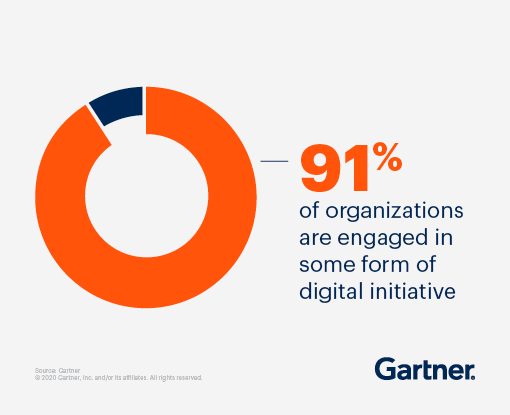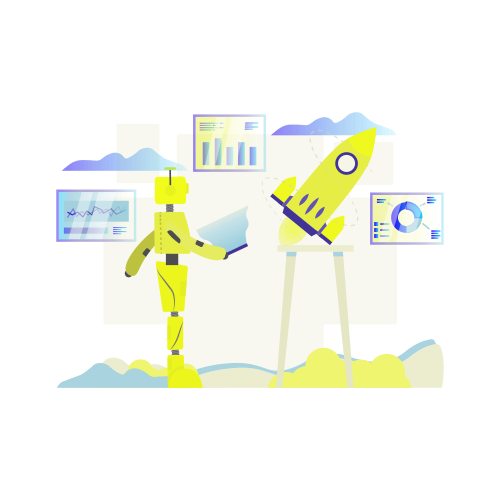Intelligent Automation: The Next Step in Digital Transformation
Digital transformation is a buzzword that has become synonymous with any business’ attempt at modernization. Whether it be from small merchants establishing an online presence with simple e-commerce software to major healthcare providers digitizing paper records, these initiatives are all thrown under the digital transformation umbrella.
For large enterprises, digital transformation is by no means a foreign concept, but it is a little more advanced than, say, establishing an online presence.
What is Digital Transformation?
Digital transformation is the implementation of technology in all areas of an organization to deliver more value faster to their customers. It’s a holistic, comprehensive shift in how the entirety of the business operates. New technologies are implemented to optimize or develop entirely new business processes to modernize how they function and serve their market.
This holistic change also demands a shift in culture where innovation is embraced and evangelized. New and emerging technology must continually be adopted to keep pace with the competition and respond to customer and market demands.
Digital transformations even created a new executive: the Chief Innovation Officer (CIO). CIOs were ushered into the executive in the 1980s as the digital economy was in its infancy. At the time, the CIO was created and enlisted to help organizations find leaders that would help them adopt and use mainframe computers. The position, obviously, still exists. And while mainframe computers are no longer what large organizations need help with, today, technology is rolled out at a hyper-fast pace, and CIO’s work to analyze and implement where appropriate.
Why are Businesses Undergoing Digital Transformations?
Businesses need to evolve from legacy technologies, archaic processes, and outdated methodologies. Above all, digital transformation is rooted in the need to respond to customer demands and compete against the digital disruptors threatening their business.

We are very much in a digital economy where customers expect a digital-first experience. In large part, it was the start-ups and digital disruptors that created this learned behavior and expectation. By leveraging technology, smaller, tech-based companies could deliver faster, better experiences with fewer fees because big labour forces weren’t needed to provide their services to customers.
For example, tech giants like Facebook and Apple have taken a big bite out of telecom’s revenue streams with over-the-top services like WhatsApp, Messenger, or FaceTime that run on the networks the telecoms built and maintain.
Banking and Financial Services is another key industry challenged by small, agile disruptors that offer a better user experience with lower service costs, forcing large organizations to quickly respond by providing the same digital services. This new mandate demands the digitization and integration of new technology and a shift in culture that embraces innovation and constant change for internal improvement.
This is why robotic process automation (RPA) is an integral part of digital transformation. Automating routine tasks and business processes is part of a holistic change that improves process quality and execution, increases operational efficiency, and most importantly, improves the customer experience. RPA, however, is just the beginning. Large enterprises are now evolving to the next step of digital transformation: intelligent automation.
What is Intelligent Automation?
Intelligent automation is the combination of robotic process automation (RPA) and artificial intelligence (AI) to automate complex end-to-end processes.
Intelligent automation uses AI technologies like machine learning, computer vision, and natural language processing (NLP) to move beyond basic, rules-based tasks and tackle decision-based processes. The objective is to automate more end-to-end processes to become quicker and more efficient.
While RPA is very capable at automating repetitive, rules-based tasks that present little variation, the processes selected for automation are typically smaller, decomposed processes of much larger, complex ones. For example, extracting information from invoices to input them into ERPs (enterprise resource planner) is a very common task that’s automated using RPA. Still, it’s only a small piece of the much larger flow to process invoices end-to-end.
Intelligent automation would automate much more of that process and remove the human intervention that introduces error and decreases execution speed. For example, machine learning can be used to review the invoice for compliance. Decision modeling software can be leveraged to automate the checks that managers or finance teams would perform manually, and so on.
What is the Future of Automation in Digital Transformations?
Digital transformations were born out of a need to become more efficient, agile, and deliver value and better customer experiences. Automation is at the heart of that. Logically, the future of automation as a driver of digital transformation is whatever will pave the road to more complex, end-to-end automation, and that is intelligent automation.
Banking and Financial Services have already seen significant returns from implementing intelligent automation in the form of improved regulatory compliance. All industries have seen an uptick in cost reduction and process quality; that is, when they get it right.
How Blueprint Enables Intelligent Automation at Scale?
Just like RPA, intelligent automation is still susceptible to maintenance issues surfacing from poor design and development that leads to downtime, preventing scale, and the project from delivering on its objectives in the form of ROI.
As the world’s most powerful automation design environment, Blueprint’s Enterprise Automation Suite facilitates 100% bot availability to maximize the returns from your investment in intelligent automation. Blueprint sits in the middle of your intelligent automation toolchain. It integrates with the leading RPA tools, providing a new way to design, plan, and communicate intelligent automation work with Digital Blueprints.
Digital Blueprints are automatically synced with your RPA tools to provide your automation engineers with all the precise guidance and rich context they need to automate more complex, end-to-end processes at a higher quality.
In a recent automation virtual conference, we presented how Blueprint facilitates design and delivery for higher-quality automations that maximize uptime. Watch the on demand webinar Watch this short video and discover how Digital Blueprints enable Intelligent Automation at scale to fuel your digital transformation.
Image source: Gartner, Digitalization strategy for Business Transformation, https://www.gartner.com/en/information-technology/insights/digitalization
Share this
Recent Stories

Intelligent Automation Solutions for Enterprise Processes

From RPA to APA: Unlocking the Next Era of Intelligent Automation



